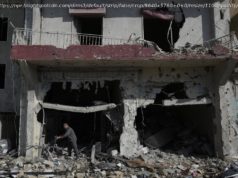Analysts say the extremist group has proven to be resilient and able to replenish leadership quickly, making it a continued threat
As the toll rises above 300 from one of the world’s deadliest attacks in years, the al-Shabab extremist group has sent a powerful signal that the international focus on extremism cannot afford to overlook the African continent.
Saturday’s truck bombing on a crowded Mogadishu street showed that al-Shabab, targeted for years by US air strikes and tens of thousands of African Union forces, has once again made a deadly comeback.
Pushed from Somalia’s capital in recent years, al-Shabab has retreated mostly to rural areas of the country’s south, where the fragile central government is unable to assert its authority and local fiefdoms are in charge.
From there, Africa’s deadliest Islamic extremist group has continued to plan guerilla-style attacks like Saturday’s truck bombing in the capital, Mogadishu.
Somalia’s al-Shabab militants attack military base outside Mogadishu, claim to kill 17 soldiers
While showing al-Shabab’s resilience in the face of new military offensives by the US and Somalia in recent months, the attack also highlights the shortcomings of US drone strikes in a politically fraught country with a weak military and even weaker police, analysts said.
“Decapitation strikes certainly serve a purpose, but al-Shabab will not be defeated this way. They replenish leadership very quickly,” said Matt Bryden, a security consultant on the Horn of Africa who once served as a United Nations expert.
Although al-Shabab has not claimed responsibility for Saturday’s attack, the Somali government says there can be no doubt. Bryden agreed, saying “no other group in Somalia has the capacity to put together a bomb of this size, in this nature”.
Mohamed Sheikh Abdi, a political analyst in Somalia, said he believed al-Shabab is reluctant to take credit for the attack because the high civilian death toll would hand “an expensive propaganda prize for the government… as a rallying call and boost its public image”.
The extremist group earlier this year vowed to step up attacks in response to new military efforts by both the Trump administration and Somalia’s recently elected Somali-American president.
It is not yet clear how the US military will respond to Saturday’s bombing.
The extremist group knows how to make a comeback. It suffered perhaps its worst setback in 2014 after a US air strike killed its spiritual leader Ahmed Abdi Godane, who had helped forge the group’s alliance with al-Qaeda. Godane was quickly replaced by the more reclusive Ahmad Umar, who remains at large.
In the past year al-Shabab attacks, including against the 22,000-strong multinational African Union force in Somalia, have become more frequent. About half of the 1,228 civilian casualties recorded by the UN this year in Somalia have been caused by the extremist group.
Somalia saw a 38 per cent rise in civilian deaths from improvised explosives in the first half of this year, the London-based Action on Armed Violence said Monday.
“Time and again throughout its history … al-Shabab has shown itself to be a remarkably resilient group,” said J. Peter Pham, director of the Africa Centre at the Atlantic Council.
“There is no reason to believe that it will not also survive in some fashion the recent setbacks it has suffered in terms of strikes and defections.”
Over the years al-Shabab has grown from mounting low-level, symbolic assaults to staging complex attacks at home and abroad. The group is responsible for two major attacks that killed scores in neighbouring Kenya, at Garissa University in 2015 and Westgate Mall in 2013. Al-Shabab called them retaliation for Kenya’s military involvement in Somalia.
Al-Shabab’s attacks have persisted despite the efforts of the international community, which has invested millions of dollars in training the Somali national army. That is due in part to the fragility of Somalia, known as a failed state for decades as it was torn apart by conflict and clan disputes. The central government now struggles to assert control beyond key areas like Mogadishu.
Somalia – a key bridge between Africa and the Middle East and separated by a narrow strait of water from another chaotic nation, Yemen – is historically a complicated country for the United States. The US pulled out of Somalia after the 1993 incident in which two helicopters were shot down in Mogadishu and bodies of Americans were dragged through the streets.
But in April, after the Trump administration expanded military operations in Somalia, the US announced it was sending dozens of regular troops in the largest such deployment to the country in roughly two decades. The US said it was for logistics training of Somalia’s army. Weeks later, a US service member was killed during an operation against al-Shabab.
Bryden said the training efforts of the US and others have become “too centralised in Mogadishu” and too focused on the army, without any serious efforts to boost the capacity of police and regional forces.
The government has fewer than five officers who have been trained in investigating crime scenes caused by improvised explosives, he said.
Saturday’s attack appeared to take advantage of the country’s latest security turmoil, coming two days after Somalia’s defence minister and army chief resigned for unknown reasons.
As the death toll continued to rise, the African Union, which is set to withdraw its forces and hand over the country’s security to the Somali military by the end of 2020, asked the international community for help.
“It is now clear that without adequate and appropriate support to Somalia, many of the security gains made in recent years could be reversed,” the continental body said in a statement.
Home
United States
USA — mix Death toll from truck bombing rises above 300 as Somalia fears renewed...






